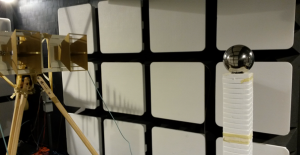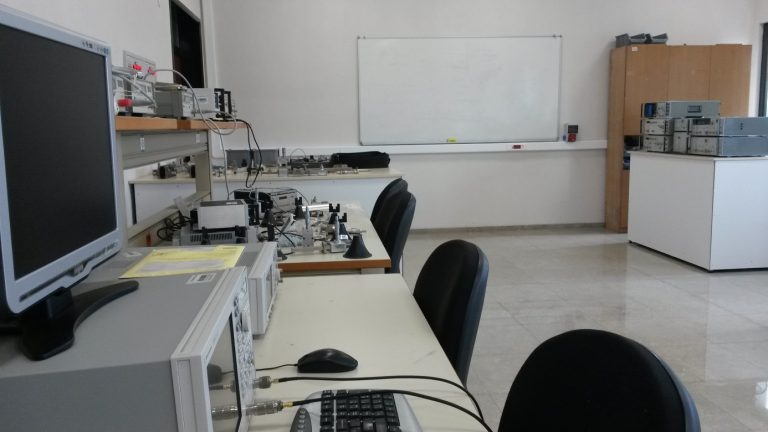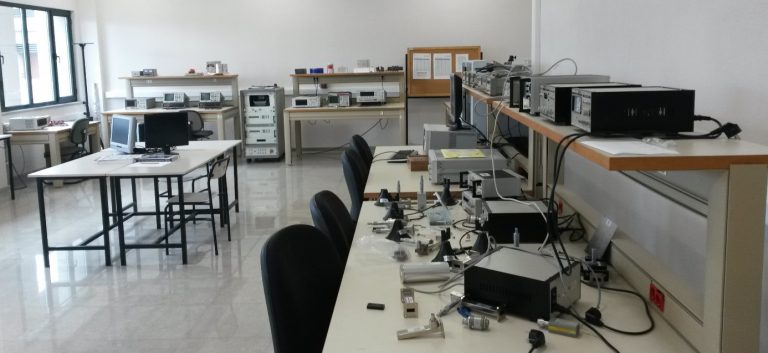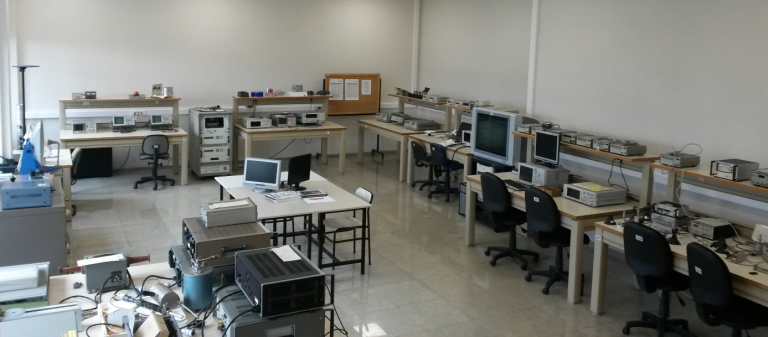Antennas and Microwaves Laboratory
Academics
- Prof. Dr. Alp Kuştepeli
- Assoc. Prof. Dr. Fatih Yaman
- Res. Asst. H. Önder Yılmaz
- Res. Asst. Anıl Karatay
- Res. Asst. Ceren Özkal
Main Research Topics
- RF and Microwave Systems and Circuits (design, simulation, realization, measurements)
- Computational electromagnetics (FDTD and MoM)
- Antenna design, simulation realization
- Short-range Doppler Radar design, realization
- Dielectric Measurements simulation, design, realization
Projects
- Experimental Investigations of Electromagnetic Effects for Mechanical Defects Occur in the Production of Particle Accelerator Cavities (2019-2020)
- Metamaterial Antenna Design for 5.8 GHz Doppler Radar (2018-2019)
- Switchless bidirectional amplifier
- Excitation of the groove guide resonator at 10 GHz. (TUBITAK-1 year)
- Design, simulation, and realization of the groove guide oscillator in the microwave band and its industrial applications (TUBITAK-3 years)
- Antennas and RF-systems for wireless consumer electronics (2005-2006)
- Active antennas for DVB-T systems (2006-2009)
Publications
Journal Articles
- Yaman, Fatih “Numerical investigations of resistive wall wake potentials” 2020, Electronics Letters, 56 (3), 129-132.
- Yilmaz, Hasan Onder; Yaman, Fatih “Meta-material Antenna Designs for a 5.8 GHz Doppler Radar” IEEE Transactions on Instrumentation and Measurement, 2020, 69 (4), 1775-1782.
- Yaman, Fatih “Quantification of resistive wall instability for particle accelerator machines” 2019, Turkish Journal of Electrical Engineering & Computer Sciences 27 (6), 4756-4767.
- Karatay, Anıl; Yaman, Fatih “Electromagnetic Simulations of Mechanical Imperfections for Accelerator Cavities” 2019, IEEE Transactions on Nuclear Science 66 (11), 2295-2304.
- Karatay, Anıl; Orcan, Durmuş; Özkal, Ceren; Yaman, Fatih “Implementation and experimental verifications of microstrip antennas for angular scanning of a Doppler radar” 2019, AEU-International Journal of Electronics and Communications 101, 76-84.
- Sümer, Can; Kustepeli, Alp; Dinleyici, Mehmet Salih “Investigating the experimental limits of the Brewster’s angle method” Turkish Journal of Electrical Engineering and Computer Sciences, 2018, 26 (3), 1202-1213.
- Bozdag, Goksenin; Kustepeli, Alp “Subsectional Tapered Fed Printed LPDA Antenna with a Feeding Point Patch” IEEE Antennas and Wireless Propagation Letters, 2016, 15 (1), 437-440.
- Kustepeli, Alp “On the Helmholtz Theorem and Its Generalization for Multi-Layers” Electromagnetics, 2016, 36 (3), 135-148.
- Bozdag, Goksenin; Kustepeli, Alp “Wideband planar monopole antennas for GPS/WLAN/WiMAX/UWB and X-band applications” Microwave and Optical Technology Letters, 2016, 58 (2), 257-261.
- Bozdag, Goksenin; Kustepeli, Alp “WIDEBAND PRINTED PLANAR MONOPOLE ANTENNA FOR PCS, UWB AND X-BAND APPLICATIONS” Progress In Electromagnetics Research C, 2016, 60, 95-103.
- Desde, Irem; Bozdag, Goksenin; Kustepeli, Alp “Multi-band CPW fed MIMO antenna for bluetooth, WLAN, and WiMAX applications” Microwave and Optical Technology Letters, 2016, 58 (9), 2182-2186.
- Yaman, Fatih; et al. “Recent theory and applications on inverse problem” 2015, Mathematical Problems in Engineering 2015.
- Kustepeli, Alp “Revised Distributional Forms of the Laplacian and Poisson’s Equation, Their Implications, and All Related Generalizations” Electromagnetics, 2015, 371-385.
- Hilavin, Sezgin; Kustepeli, Alp “Design and implementation of a TEM stripline for EMC testing” IEEE Transactions on Electromagnetic Compatibility, 2014, 56, 23-27.
- Saynak, Ugur; Kustepeli, Alp “Novel Square Spiral Antennas for Broadband Applications” Frequenz, 2009, 63 (1,2), 14-19.
- Ozbakis, Basak; Kustepeli, Alp “The resonant behavior of the fibonacci fractal tree antennas” Microwave and Optical Technology Letters, 2008, 50 (4), 1046-1050.
- Thomas F; Kustepeli, Alp; Bechteler, Sevinc A “Design of coupling structures for groove guide resonators” Microwave and Optical Technology Letters, 2008, 50 (5), 1406-1410.
Conference Publications
- Yaman, Fatih “A Numerical Investigation for the Electron Cloud Build-Up Mechanism” In proceedings International Science, Mathematics and Engineering Sciences Congress, 2019.
- Ogur, Salim; et al. “Linac and Damping Ring Designs for the FCC-ee” Inproceedings 2019 10th Int. Partile Accelerator Conf.(IPAC’19), pp. 420-423, Melbourne, Australia.
- Özkal, Ceren; Yaman Fatih “Investigations for Increasing the Accuracy of Dielectric Constant Measurements” Inproceedings 2019 Book of Full Text Proceedings Turkish Physical Society 35th International Physics Congress (TPS35), pp. 74-81, Mugla, Turkey.
- Karatay, Anıl; Yaman Fatih “Fully 3D Printed Bead-Pull Measurement of an Elliptical Cavity” Inproceedings 2019 Book of Full Text Proceedings Turkish Physical Society 35th International Physics Congress (TPS35), pp. 42-49, Mugla, Turkey.
- Yılmaz, Hasan Önder; Yaman Fatih “Reconstruction of Medium Parameters for Metamaterial Antennas via Retrieval Method” Inproceedings 2019 Book of Abstract Turkish Physical Society 34th International Physics Congress , 2019, Mugla, Turkey.
- Karatay, Anıl; Yaman Fatih “Electromagnetic Simulations of Mechanical Imperfections for Elliptical Cavities” Inproceedings 2018 Book of Abstract Turkish Physical Society 34th International Physics Congress , 2018, Mugla, Turkey.
- Yılmaz, Hasan Önder; Yaman Fatih “Meta-Material Antenna Design for 5.8GHz Doppler Radar” Inproceedings 2018 Book of Abstract Turkish Physical Society 34th International Physics Congress , 2018, Mugla, Turkey.
- Özkal, Ceren; Yaman Fatih “The Cavity Perturbation Method for the Dielectric Constants Measurements” Inproceedings 2018 Book of Abstract Turkish Physical Society 34th International Physics Congress , 2018, Mugla, Turkey.
- Cetinkaya, Hakan; et al. “KAHVE Laboratory RF circulator and transmission line project” Inproceedings 2018 AIP Conference Proceedings 1935 (1), 070002.
- Bursalı, Hikmet; Yaman Fatih “The Cavity Perturbation Method for the Dielectric Constants Measurements” Inproceedings 2016 Book of Abstract UPHUK VI.
- Turemen, Gorkem; et al. “Current Status of The Sanaem Rfq Accelerator Beamline” Inproceedings 2015 International Particle Accelerator Conference, pp. 3952-3955, Richmond, USA.
- Ozbakis, Basak; Oguzer, Taner; Kustepeli, Alp “Electromagnetic scattering from arbitrary flat plates: Analysis of the problem by using method of moments with different sinc type basis functions” Inproceedings 2011 30th URSI General Assembly and Scientific Symposium, URSIGASS 2011, 2011, ISBN: 9781424451173, Istanbul, Turkey.
- Ozbakis, Basak; Oguzer, Taner; Kustepeli, Alp “Three-dimensional electromagnetic scattering from flat plates by using sinc-type basis functions in method of moments” Inproceedings 2009 Computational Electromagnetics International Workshop, CEM 2009, 2009, pp. 61-64, Izmir, Turkey.
- Saynak, Ugur; Kustepeli, Alp “A novel square-spiral strip antenna” Inproceedings INICA 2007 International Conference on Antennas – Proceedings, 2007, ISBN: 9783000216435.
Thesis
- Title: Elliptical cavity designs, fabrications and experiments to investigate cell misalignment and surface roughness effects
Author: Anıl Karatay
Year: 2019
Supervisor: Fatih Yaman
Type: Master’s Thesis
Abstract: In this thesis, the results of 5 different elliptical cavity designs at different cell numbers and frequencies and the fabrication and measurement of two of these are presented in order to investigate the effects of cell alignment error and surface roughness. First, a 9-cell, 3.9 GHz elliptical cavity with very poor cell-to-cell coupling is designed and the acceleration parameters are optimized. Thanks to the low cell-to-cell coupling, it is aimed to better observe possible mechanical defects and the effects of cell alignment errors in this cavity on the fundamental cavity parameters and particle-cavity interaction are investigated using CST-MWS program. In addition, the effect of surface roughness of the cavity on wake fields and impedances is among the parameters that are tried to be observed. Second, a 3-cell 2 GHz cavity and its scaled version, 3-cell 3.9 GHz cavity, are designed to demonstrate that the effects of cell misalignment were not limited to only this geometry, and similar simulations are repeated for these cavities. In the experimental part of the thesis, a 3-cell 3.9 GHz elliptical cavity with high cell-to-cell coupling is designed and fabricated with a 3D printer and made conductive by nickel and copper coating techniques. Then, the effects of cell misalignment on the quality factor and the electric field on the acceleration axis are investigated experimentally. For these processes, bead-pull measurement is utilized in addition to weak and critical coupling measurements. In the last part, a 2.45 GHz single cell aluminum cavity is fabricated, the same experiments are repeated and it is experimentally demonstrated that similar effects can also be observed with higher conductivity values.
- Title: Design and measurements of microwave cavity and coupler for a klystron test stand
Author: Aslıhan Çağlar
Year: 2019
Supervisor: Fatih Yaman
Type: Master’s Thesis
Abstract: In recent years, usage of high power in modern technologies operating at microwave frequency range has been varying in research topics such as radar, plasma science, satellite communications and particle physics. Therefore, transmission of high power from a power generator to a specific target without loss is a key point of these research fields. In accordance with this purpose, a project has been started at the Kandilli Detector, Accelerator and Instrumentation (KAHVE) Laboratory of Boğaziçi University in Turkey which name is Design, Simulation and Production of an RF Circulator and Transmission Line. The aim of the project is to build a high power RF transmission line and circulator operating at 800 MHz frequency. In order to perform this whole system after their installing, a simple pillbox cavity has been designed, simulated and fabricated. A cavity is not enough itself to test the system because an efficient high power transmission section from the RF power generator to the pillbox cavity is needed. In this regard, an input power coupler with a loop antenna has also been produced. Overall, several measurements have been performed to compare with simulation results and to determine whether the performance of the transmission line is adequate for high power applications and consistent results were obtained in accordance with the project targets.
- Title: Metamaterial antenna design for 5.8 GHz Doppler radar
Author: Hasan Önder Yılmaz
Year: 2018
Supervisor: Fatih Yaman
Type: Master’s Thesis
Abstract: This thesis presents mainly simulation and measurement results of metamaterial based transmitter and receiver antennas for a Doppler radar system operating at 5.8 GHz and indoor, outdoor and through-wall performances of the Doppler radar system after the integration of field and the realized transmitter and receiver antennas. Firstly, the antennas are modeled via 3D electromagnetic simulation program CST:Microwave Studio and related parameters are calculated. Afterwards, in order to observe antenna performances, radiation pattern and gain characteristics of realized antennas are measured in laboratory environment including anechoic chamber. Another essential objective of this thesis is to examine and analyze applicability and effectiveness of the metamaterial based antennas for a 5.8 GHz Doppler radar system. For this reason, a double negative index metamaterial structure is integrated to a patch antenna for the transmitter. For the receiver antenna, a near-zero index medium is designed to locate over patch antenna. Accordingly, significant improvements in size and bandwidth for the transmitter and in gain and directivity for the receiver in addition to improvement of its psychical size are obtained. It is shown that return loss, radiation pattern and gain measurement results of the designed antennas agree well with the simulations for a desired frequency band. According to the experimental data, the realized transmitter antenna has a higher directivity value as compared to the simulated one, therefore it radiates most of the power into narrower area. Additionally, the measured one has a wider bandwidth. The measurement results of receiver antenna are consistent with simulation in terms of bandwidth, return-loss, radiation pattern of horizontal direction and gain value. The last part of the thesis is devoted to expressing the application of the designed antennas to the low-power, short-range Doppler radar system, which is designed to detect the speed of the human or moving target in the indoor/outdoor environment or behind the wall. Improvements on the performance of the radar system integrated with metamaterial antennas are discussed and performances results are commented.
- Title: Simulations and measurements of X-band accelerating structures for the CLIC project
Author: Hikmet Bursalı
Year: 2018
Supervisor: Fatih Yaman , Nuria Catalan Lasheras
Type: Master’s Thesis
Abstract: The Compact Linear Collider (CLIC) Project is 50 km long e−, e+ linear collider planned to be built in three stages with 3 TeV center-of-mass energy at its last stage. The CLIC accelerator includes around 140000 accelerating structures. The cost optimisation process is ongoing before the production stage. In order to obtain the CLIC design requirements, the accelerating structures are machined out of OFE copper and ultra precision turning and milling with single diamond tool. The required precision on the order of the micron makes the final product relatively expensive. The assembly of these copper parts is done by electron beam welding of two halves or diffusion bonding of disc stacks. In this thesis we investigate the potential geometrical correlation between the imperfection of the accelerating structure discs inner radii and their individual frequency deviations before and after bonding. Following the results of this work, the tolerance study of the machining and bonding effects will be understood and manufacturing process will be optimised for cost saving.
- Title: Novel microstrip antennas for multiband wideband applications
Author: Göksenin Bozdağ
Year: 2014
Supervisor: Alp Kuştepeli
Type: Master’s Thesis
Abstract: In this study, four novel microstrip antennas are designed for various wireless systems in two different types which are log periodic dipole array and planar monopole. In the first design, multiband behavior of standard printed log periodic dipole array antenna is converted to wideband by employing sub-sectional tapered feeding and the operating bandwidth is increased by using a feed point patch. By the way, the proposed antenna becomes capable of GPS (L1 and L2), PCS, IMT-2000, WLAN, WiMAX, UWB and X Band systems. The other designs are printed planar monopole antennas which have small size and low group delay. Microstrip inset feeding, sectional design and slot loading methods are basically used for these antennas. First printed planar monopole antenna is designed for WLAN, WiMAX, UWB and X Band applications by employing inset feeding and sectional design. In the second and the third printed monopole designs, slot loading technique is also employed. It provides both exciting extra resonance frequencies and keeping S11 performance below -10 dB level. In the second design, a novel slot geometry is implemented on the first printed monopole design for PCS band. Then, desired frequency resonance with required bandwidth is reached and the antenna becomes capable of PCS in addition to UWB and X Band. In the third design, another novel slot geometry is also implemented on the first printed monopole design for GPS band. Consequently, the antenna becomes capable of GPS in addition to WLAN, WiMAX, UWB and X Band.
- Title: Design and calibration of a TEM stripline for electromagnetic compatibility testing
Author: Sezgin Hilavin
Year: 2011
Supervisor: Alp Kuştepeli
Type: Master’s Thesis
Abstract: Electrical products are used in every aspect of our lives. Every electrically device has the potential of causing unintentional interference to other electrical devices. All unwanted currents or voltages that may arise in a system generate electrical noise. All kinds of unexpected radio-frequency (RF) energy produce this kind of noise. The term Electromagnetic Interference –EMI – describes the situation that electrical noise destroys the functionality of systems. Therefore, emissions and immunity tests have to be performed according to the harmonized European norms like EN55020 standard. In this thesis, immunity to radiated fields testing will introduce and the basic requirements of the suggested test site which is a TEM stripline will also be mentioned. Stripline is a transmission line construction which provides a uniform electromagnetic field between its parallel plates. Radiated immunity can be defined as the product’s ability to withstand EM energy that arrives via free-space propagation for its functionality. Design of a new TEM stripline for EMC testing is given in order to construct an alternative test site, a new stripline bigger than the one given by the standard was built. Main attention has been focused on the design parameters (characteristic impedance, field uniformity etc.) and calibration of the designed stripline. Defined stripline in the standard has 80 cm height but it is not sufficient for big equipment under test (EUTs). Then an alternative stripline can be used if it fulfills the specifications required by the standard.
- Title: Setup and calibration of a heterodyne receiver for microwave sensors
Author: Saygın Bildik
Year: 2008
Supervisor: Sevinç Aydınlık Bechteler
Type: Master’s Thesis
Abstract: The demand for sensors for the measurement of various quantities has increased with the automatisation of industrial processes. In many cases microwave techniques provide competitive solutions. A large number of important applications are found such as dielectric constant measurement, moisture measurement, length measurement, leaking gas detection, radar applications, etc. Heterodyne receiver system is set up and calibrated to measure the resonant frequencies of resonator type sensors precisely and inexpensively. Output frequencies of the resonator type sensors are varied by the change in physical dimensions of the resonator or physical properties of a material placed in a resonator to be processed. Instead of the classical audio amplifier and a loudspeaker which are the elements of a classical heterodyne receiver, a frequency counter evaluates the signal. Thus, the heterodyne receiver used in frequency measurement system consists of a mixer, a voltage controlled oscillator, a microstrip line low-pass filter and a frequency counter. The output signal of the resonator is converted down to an intermediate frequency which is in the counting range of frequency counter via the mixer with VCO. Then, the measured data is sent to a computer and it is converted to the wanted data related to which measurement (distance, dielectric constant, etc.) is done and which resonator is used. In this study, distance measurement is performed by using a circular groove guide oscillator as a microwave sensor connected to the heterodyne receiver system. The most important feature of the groove guide oscillator is its resonator consists of physically two open parallel plates. Therefore, the resonant frequency of the oscillator can be changed depending on the distance between the two parallel plates. This makes the groove guide oscillator feasible for some applications like the distance measurement, using the resonant frequency measurement setup.
- Title: Novel rectangular spiral antennas
Author: Uğur Saynak
Year: 2008
Supervisor: Alp Kuştepeli
Type: Master’s Thesis
Abstract: Round spiral antennas are generally designed by using Archimedean spiral geometries which have linear growth rates. To obtain smaller antennas with nearly the same performance, square spiral Archimedean geometries are also widely used instead. In this study, novel square antennas are proposed, designed and examined. At first two similar but different approaches are employed to design new antennas by considering the design procedure used to obtain log-periodic antennas. Then, the performance of these antennas is improved by considering another property of log-periodic antennas. Simulations are performed by using two different numerical methods which are Finite Difference Time Domain Method (FDTD) and Method of Moments (MoM). The results obtained from the simulations are compared with those of the Archimedean spiral antennas in terms of the frequency dependency of fundamental antenna parameters such as antenna gain and radiation pattern. The simulation results are compared with the ones obtained from the experimental study.
- Title: Fibonacci fractal tree antennas
Author: Başak Özbakış
Year: 2004
Supervisor: Alp Kuştepeli
Type: Master’s Thesis
Abstract: Fractal geometry is first defined by Benoit Mandelbrot. A fractal structure is generated with an iterative procedure of a simple initiator by replicating many times at different scales, positions and directions. Fractal structures generated with this method are generally self-similar and the dimensions of these structures cannot be defined with integers. Koch, Minkowski and Sierpinski structures are the most known fractal structures. These structures are commonly used as multiband and wideband antenna designs because of the self-similarity. Furthermore, their special geometry is useful to obtain small antennas which are resonant at lower frequencies. Lowering the resonant frequency has the same effect as miniaturizing the antenna at a fixed resonant frequency. Other important and interesting fractal structures used in antenna designs are the various types of the fractal trees. However, in recent studies the branch length ratios of the fractal tree antennas are taken constant. In this study fractal tree antennas with nonuniform branch length ratios are investigated. By changing the geometry and number of branches of the fractal tree structures the antenna characteristics are examined. The branch lengths and number of branches of the fractal tree antennas are determined by using the Fibonacci sequence. Leonardo Fibonacci (1170 – 1240), a famous Italian mathematician, dealt with geometry and developed a number sequence while observing the nature. Fractal tree antennas are designed with two different geometries in order to improve the resonance behavior of the antennas. The number of branches is decreased, so that less complex fractal tree antennas with the similar performance can be obtained.
Undergraduate Projects
- Mert Can Eyil, “Comparative Tuner Design Study for a Cylindrical Cavity”
- Ömer Alptuğ Ardıç, “Microwave Filter Design for a Groove Guide Oscillator ”
- Ramazan Şalcı, Multucan Mutlu, “Phased Array Antenna Design for a Doppler Radar”
- Kübra Gül Çiftçi, “Dielectric Measurements via Microwave Cavities”
- Merve N. Dutğun, M. Emre Aydın “Design, Realization and Integration of Microstrip Phased Array Antenna for a Doppler Radar”
- Anıl Karatay, “Design, Implementation and Integration of Tx/Rx Microstrip Antennas for a Doppler Radar”
- Ceren Özkal, Durmuş Orcan, “Implementations of Angular Identification Mechanisms for a Doppler Radar”
- Ogün Kethüda, “Doppler Radar Measurements with Cantennas”
- Sinan Çelik, “Microstrip Antenna Design for Doppler Radar”
- Onur Salan ve Sinan Çelik, “Doppler Radar Design”
- Aysel Kuyumcu, “2-way and 3-way Microstrip Power Splitter Design”
- Hikmet Bursalı, “RF Pickup Antenna Design and Measurements for a Resanotor”
- Kağan Karaca, “Simulations and Measurements of Dielectric Loaded Microwave Cavities”
- Maide Altuntaş, “Design and Implementation of Microstrip Antenna for Frequency Modulated Continuous Wave Doppler Radar”
- Mertcan Dalkıran, “Design and Implementation of Microstrip Power Divider for Frequency Modulated Continuous Wave Doppler Radar”
- Berna Selçuk, “Radar Cross Section Calculations and Simulator Comparisons in Resonance Region”
- Yıldız Oral, “Analytical and Simulation Studies for Dielectric Loaded Rectangular Waveguides”
- Vecihe Alataş, “Electromagnetic Field Simulations for Particle Accelerator Cavities”
- Ahmet Kasapçopur, “Higher Order Mode (HOM) Studies for a Microwave Cavity”














